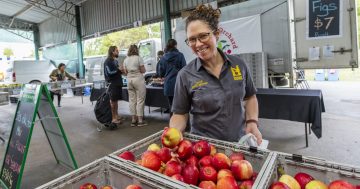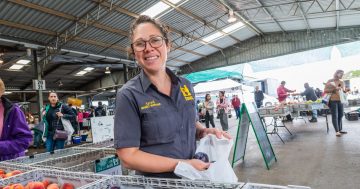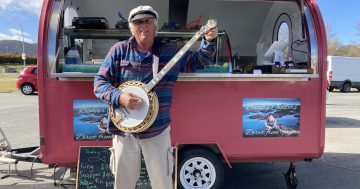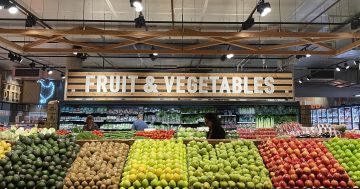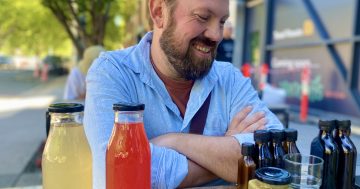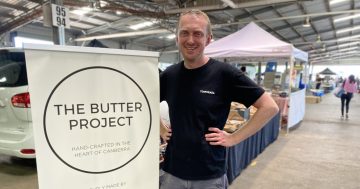 It has now become a habit for thousands of Canberrans to jump into their cars on Saturday morning and to drive to North Canberra and to make their way to a very special local retail event. According to those who run this market, the Rotary Club of Hall, about 6,000 people show up each Saturday.
It has now become a habit for thousands of Canberrans to jump into their cars on Saturday morning and to drive to North Canberra and to make their way to a very special local retail event. According to those who run this market, the Rotary Club of Hall, about 6,000 people show up each Saturday.
I have witnessed the Capital Region Farmers Market grow over the years, although I have to admit I have only seen the later hours of the operation on Saturday morning — I usually arrive around 10/10.30 (the markets close at 11.30).
Apparently there are those who get there early after it opens at 7.30 and occasionally I see stalls with the sign proudly boasting – ‘sorry, all sold out’.
Others use the event for social reasons, in that they line up for coffees and food and sit around to chat. For me, it is usually about a 30 minute walk around to load up with a range of goodies, and then out of there.


The Capital Region Farmers Market is not your usual market. Most markets offer clothes, craft object and antiques. This Canberra market purposely precludes such stalls. These markets are staged very purposefully to favour local producers and their produce.
The world is currently besieged by big retailers who set up big boxes on the edges of cities. People are then encouraged to drive out to these box retailers and to park their cars in the vast car parks. The consequence of these big boxes is that they pull shoppers away from local shops and small retailers.
Given its structure whereby the landlord provides the roof and the space for retailers to set up, it has occurred to me that the Capital Region Farmers Market is another form of big box retailing. In this case the box is a large shed in a paddock. The big box retailers have huge parking lots. These Canberra markets have available to them a huge amount of parking and much of it is taken up each Saturday. People rarely walk to big box retailers and likewise only a few locals walk to these markets from nearby Watson or maybe Downer.
But there I think the similarities end.
I suggest most people going to the Capital Region Farmers Market appreciate that the retailers they are dealing with are the producers of the goods for sale. In most cases they are happy to discuss their produce.
The farmers involved are receiving the full payment for their work, not a minimum price negotiated to favour the large corporation’s share price. That is, the money is going into their hands not off to some large national or international corporation.
I suspect that people enjoy the experience of walking down rows of stalls and taking in the varied offerings arranged to entice your money from your purse. I imagine that people enjoy the absence of special lights, shiny floors, background music and the usual slick advertising banners with their spin. I am sure they do not miss making their way down small aisles and having to encounter packers blocking the way with pallets of goods.
The markets are crowded but in a friendly way. People seem to be comfortable making their way around and having to constantly maneuver their way around other groups, children, bags and various other obstacles.
It is usual for markets to be staged in high streets, in local parks, or in venues such as showground buildings situated close enough to the centre of town. But here in the nation’s capital it is a shed in a paddock that for most means getting there by car and in some cases via some quite dodgy roads.
If a room full of Canberra planners were to have considered where such a market should be located, I suspect their choice would not have been a site just north of the showgrounds and situated well away from any shopping centres.
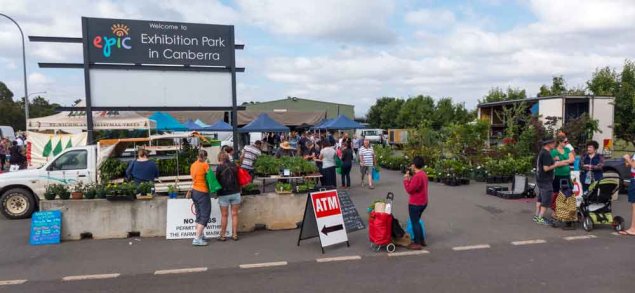

People seem to have accepted that it is OK to drive from their homes to the edge of Canberra, to make their way into these vast car parks devoid of the usual bitumen and signage etc, to wander over open spaces to a large shed despite any bad weather and to shop for local food in a very informal environment. No air conditioning here!
These markets definitely do not have the feel of being designed by a planning bureaucracy or by a big corporation. The Capital Region Farmers Market is the result of a bright idea from within the Rotary Club of Hall. And what a good idea it was!
That shed has a welcoming atmosphere and it seems that people of all ages and groupings have made it a regular Saturday morning happening.
Here’s the official reasons for these markets:
- Provide customers with a diverse range of fresh farm and food produce straight from the producer to the consumer, and an opportunity to discuss with growers and learn through weekly forays.
- Build local agri-business opportunities for regional producers to sell fresh farm and food produce.
- Provide a community dividend in the region – funds generated from the Market are fed back into regional communities and other projects chosen by the Rotary Club of Hall.
The Rotary Club of Hall is doing a great job.
And – one last thing – here’s their Christmas trading notice.












